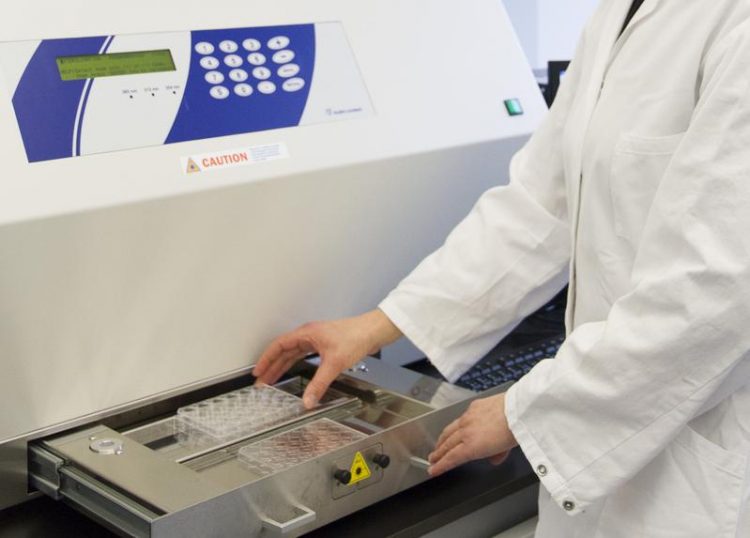Artificial skin tests for stopping sun damage

Fraunhofer researchers irradiate their skin model in the UV irradiation unit with defined non-toxic UV dosages. Fraunhofer IGB
Sunbathing without sunscreen can be dangerous. Sun rays do not only damage the skin. Some substances in drugs, cosmetics and medicinal herbs can be toxic to the skin when exposed to ultraviolet light.
Experts call the phenomenon phototoxicity. It occurs when a substance absorbs light energy and is thereby chemically modified. Only the modified substance is toxic to the skin, which can cause redness, swelling or inflammation – similar to a sunburn.
Companies can examine the phototoxicity of a substance with an in-vitro test methods developed at the Fraunhofer Institute for Interfacial Engineering and Biotechnology IGB. The test procedure is ISO certified and meets the required norms and standards.
Phototoxic substances – Feels like sunburn
The test procedure is performed on an in vitro skin model built at Fraunhofer IGB from human skin cells in special culture dishes. A fully developed epidermis model is used to study phototoxic effects. “We culture typical skin cell of the epidermis, such as human keratinocytes, in our dishes to form an artificial epidermis with all of its natural layers”, explained Sibylle Thude, the biologist who led the investigation into the accreditation.
“The typical horny layer of the skin developes on the top of the model, which acts as an important barrier against dehydration and environmental influences.”
Substances are tested on a mature epidermis model by applying them to the surface of the epidermis and exposing the model to defined, but non-toxic, doses of UV radiation. The skin cells that create the model are then tested to verify if they are still alive or have been damaged.
“We first look at the skin models under the microscope“, explained Thude. Each sample is then examined with a spectrometer to precisely quantify the extent of cell damage. “If the vitality of the skin model is damaged by more than 30 percent when compared to a non-irradiated model, we classify the test substance as a phototoxic”, said Thude. The test method is validated for aqueous solutions and oils, to the OECD Guideline 432 and the INVITTOX protocol 121, and assessed by the German Accreditation Body (DAkkS).
Self-tanning with sunscreen
Another skin model helps discover substances that stimulate melanin production of the skin. Self-tanners are of great interest, since they not only tone the skin, but also help build the body's own UV protection. To identify those substances, researchers add melanocytes to the epidermis model. Melanocytes play an important protective role in human skin: In sunlight they form the pigment melanin which adsorbs harmful UV radiation and thus prevents sunburn.
“We irradiate the pigmented skin model with UV light to directly measure increased melanin production,“ explained Thude. They also measure melanogenic substances such as L-dihydroxy-phenylalanine which is a precursor of melanin. Skin lightening substances, such as creams that hide aging spots, can also be tested on the pigmented skin model.
Since 2013, cosmetics whose ingredients have been tested on animals can no longer be sold within the EU. The Fraunhofer IGB develops alternatives based on human cells to verify the biocompatibility of substances.
Media Contact
More Information:
http://www.igb.fraunhofer.de/All latest news from the category: Life Sciences and Chemistry
Articles and reports from the Life Sciences and chemistry area deal with applied and basic research into modern biology, chemistry and human medicine.
Valuable information can be found on a range of life sciences fields including bacteriology, biochemistry, bionics, bioinformatics, biophysics, biotechnology, genetics, geobotany, human biology, marine biology, microbiology, molecular biology, cellular biology, zoology, bioinorganic chemistry, microchemistry and environmental chemistry.
Newest articles

Silicon Carbide Innovation Alliance to drive industrial-scale semiconductor work
Known for its ability to withstand extreme environments and high voltages, silicon carbide (SiC) is a semiconducting material made up of silicon and carbon atoms arranged into crystals that is…

New SPECT/CT technique shows impressive biomarker identification
…offers increased access for prostate cancer patients. A novel SPECT/CT acquisition method can accurately detect radiopharmaceutical biodistribution in a convenient manner for prostate cancer patients, opening the door for more…

How 3D printers can give robots a soft touch
Soft skin coverings and touch sensors have emerged as a promising feature for robots that are both safer and more intuitive for human interaction, but they are expensive and difficult…





















